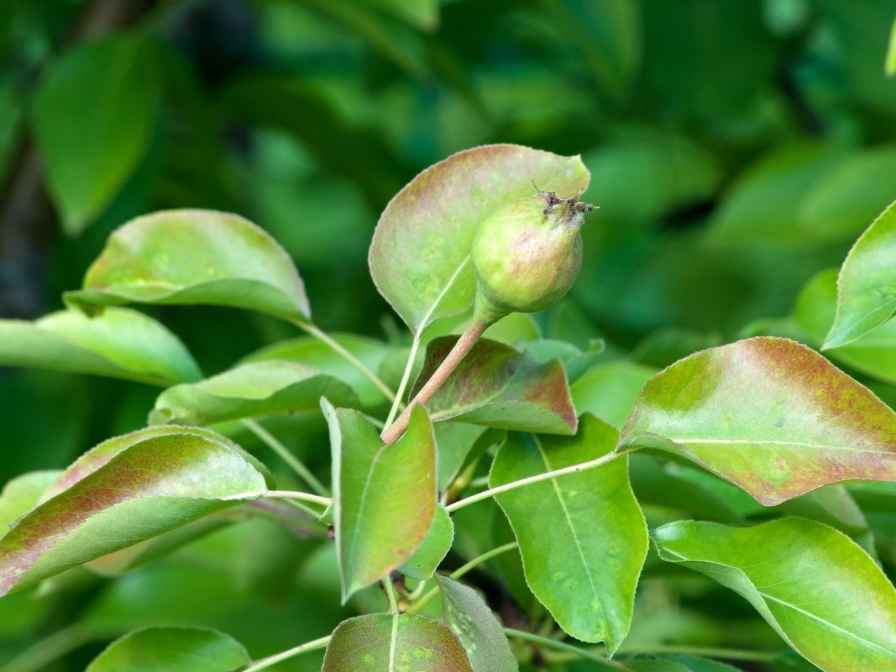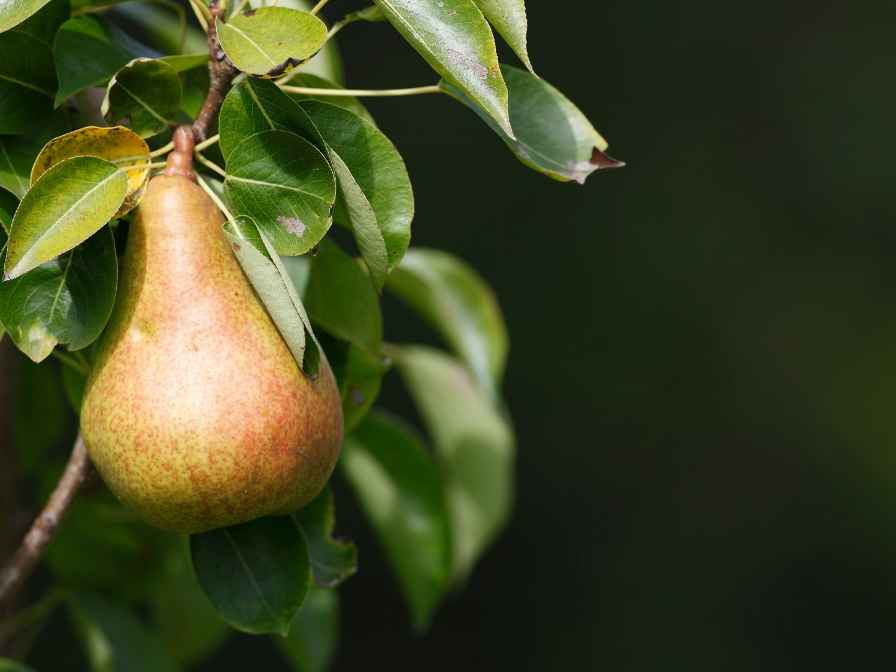Pear is a great fruit to consume. It is grown all over the world and harvested in late summer or in the month of October. Pear has a very sweet to tangy or spicy taste which is liked very much. It has a long life of almost 50 years. People do wonder how to plant pear seeds. Today we are going to discuss that.

Pear Fruit Plant
A pear is a sweet, juicy fruit that belongs to the Rosaceae family, which includes other popular fruits like apples and peaches. The scientific name of pears is Pyrus communis, and they are believed to have originated in the region that spans from the Caspian Sea to the Black Sea.
Pears come in many varieties, shapes, and sizes, with some of the most popular ones being Bartlett, Bosc, Anjou, and Comice. They are a great source of vitamin C, fiber, and copper, and they are low in calories, making them a healthy addition to any diet.
Pears can be eaten fresh or cooked, and they are often used in desserts, salads, and other dishes. When selecting pears, it’s important to choose ones that are ripe but not overripe, as pears continue to ripen even after they have been picked.
A ripe pear should be slightly soft when pressed near the stem, and it should have a sweet fragrance. Pears can be stored in the refrigerator to prolong their freshness. They should be consumed within a few days of ripening.
Pears are a popular fruit as they have been farmed for thousands of years. In addition to its culinary uses, pears have been employed in traditional medicine to treat a variety of ailments. include coughing, constipation, and sore throats. Several studies suggest that pears have anti-inflammatory and antioxidant properties. It helps to reduce the risk of contracting a number of chronic illnesses, such as cancer and heart disease.
Benefits of Planting Pear Fruit
Planting pear trees can have a range of benefits, both for individuals and for the environment. Here are some of the key benefits of planting pear fruit:
Health benefits
Pears are nutritious fruit that is rich in fiber, vitamins, and antioxidants. By planting pear trees, you can enjoy a fresh supply of this healthy fruit throughout the growing season, without having to rely on store-bought produce. Pear consumption has been associated with a number of health advantages, including better digestion, decreased inflammation, and lowered blood pressure.
Environmental benefits
By collecting carbon dioxide from the atmosphere, fruit trees, such as pears, aid in lowering greenhouse gas emissions. They also provide habitat and food for wildlife, such as bees and birds. Planting fruit trees can also help to combat soil erosion and improve soil quality. The pear trees help to hold the soil in place and add nutrients to the soil through their fallen leaves and fruit.
Economic benefits
Planting pear trees can also have economic benefits, particularly for small-scale farmers and gardeners. Pear trees can produce a significant yield of fruit, which can be sold or used to supplement a family’s diet. In addition, planting fruit trees can help to diversify a farm or garden, reducing reliance on a single crop and increasing overall resilience.
In summary, planting pear trees can provide a range of benefits, including improved health, environmental benefits, and economic benefits. Whether you are a homeowner looking to add fruit trees to your garden, or a farmer seeking to diversify your crops. Planting pear trees can be a rewarding and beneficial activity.
How to Plant Pear Seeds?
Here are the steps to follow for planting pear seeds. Just make sure you follow it right so that you might not end up losing the plants.
Choose a healthy pear fruit
Select a ripe, healthy pear fruit that is free of damage or disease. The fruit should be fully ripened before harvesting to ensure that the seeds are mature. Do check for any cuts. You will get good seeds from ripened pear fruit.
Extract the seeds
Cut the pear fruit in half and use a spoon to scoop out the seeds from the core. Rinse the seeds in a sieve or strainer to remove any remaining fruit flesh. Get seeds that are good for your health. If damaged remove them.
Stratify the seeds
Pear seeds require a period of cold stratification to break their dormancy and promote germination. The seeds should be wrapped in a wet paper towel and put in a tight plastic bag to stratify. Put the bag in the refrigerator for 8 – 10 weeks after marking it with the date and the type of pear.
Prepare the planting site
Choose a location with well-draining soil and good sun exposure. Create a hole that is twice as broad and deep as the seedling’s root ball. Verify that you have the proper soil. It is available for planting from September to January.
Plant the seeds
Once the stratification period is complete, remove the seeds from the refrigerator and plant them in the prepared hole. Cover the seeds with soil and water thoroughly. Don’t overwater the plants. Just provide enough moisture.
Care for the seedlings
Keep the soil moist but not waterlogged. As the seedlings grow, thin them to one per planting hole. Fertilize the seedlings with a balanced fertilizer every four to six weeks during the growing season.
Transplant the seedlings
Once the seedlings reach a height of 12-18 inches, they can be transplanted to their permanent location. Dig a hole that is as deep and wide as the root ball of the seedling, and plant the seedling at the same depth as it was in its original location. Water thoroughly after planting.
Maintain the trees
Pear trees require regular pruning and care to ensure healthy growth and fruit production. Prune the trees in the early spring or late winter to remove diseased or dead branches and to shape the tree. Water the trees during dry periods, and fertilize annually with a balanced fertilizer.
Taking Care of Pear Fruit Plants

Once you have grown and planted the pear fruit trees, now it’s time to take good care of it. Here are tips to follow the caring schedule for the pear plants.
Watering
Young pear trees require regular watering during the growing season, particularly during dry spells. Water the trees deeply once a week, providing 1-2 inches of water. Be careful not to overwater, as this can lead to root rot.
Fertilizing
Pear trees benefit from regular fertilization to ensure healthy growth and fruit production. Fertilize the trees in early spring with a balanced fertilizer, such as a 10-10-10 blend. Up to 10 pounds per tree, apply the fertilizer at a rate of 1 pound each year of tree age.
Pruning
Pruning is an important part of caring for pear trees, as it helps to shape the tree, improve air circulation, and promote fruit production. Before the buds emerge in the early spring or late winter, prune the trees.
As well as any branches that are crossing or rubbing against one another, remove any dead or diseased wood. Thin out the center of the tree to improve air circulation and light penetration.
Pest & disease control
Pear trees can be susceptible to a range of pests and diseases, including pear psylla, codling moth, and fire blight. To control pests, use insecticidal soap or neem oil, and apply according to the manufacturer’s instructions. To control diseases, prune out infected wood and apply a copper fungicide.
Harvesting
Pear fruits are ready to harvest when they are mature but still firm. To test for ripeness, gently press on the fruit near the stem. If it yields slightly, it is ready to harvest. Use pruning shears to cut the fruit from the tree, leaving a short stem attached.
In a nutshell, you can easily plant pear seeds. You just need to get the seeds and make them germinate. Plant them and take good care of the plants to get a good harvest. Just have patience while growing pear fruit seeds and you will get a very good harvest.
FAQs
How long does pear germination take?
It can take 2.5 to 3 months to germinate the pear fruit seeds. Just make sure you take good care to get healthy seedlings. When it grows more than 12 inches you can transplant them.
Are pears hard to grow?
You can easily grow the pear in the US harness zones from 3 to 10. Just follow the steps to make them germinate. Some of the varieties can also be grown in containers or in small spaces.
How long does it take to grow a pear?
For pear you need patience. Pear fruit trees can take 3 to 10 years to bear fruit if proper care is there. Once it has grown well and it is mature you will get a lot of pear fruit.

